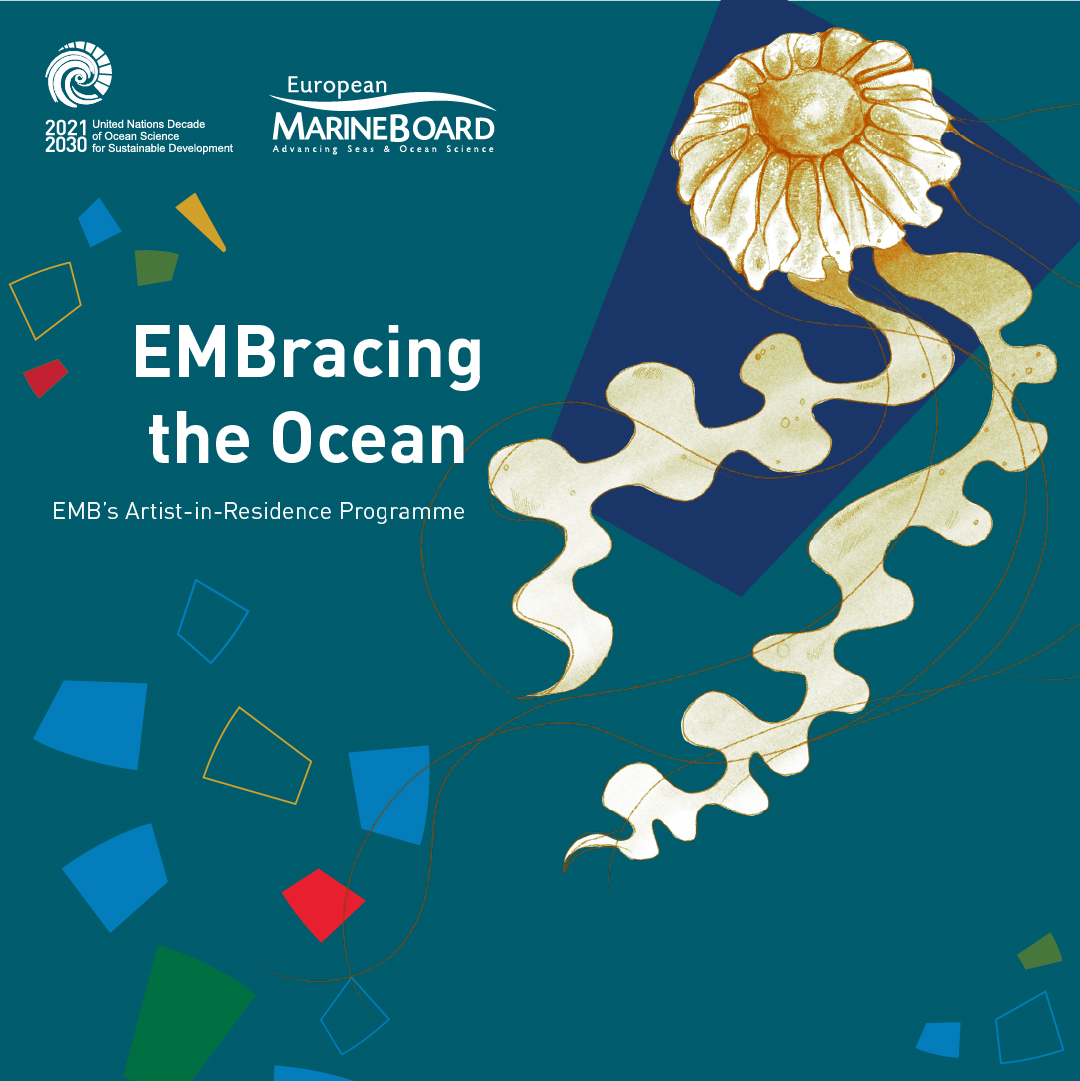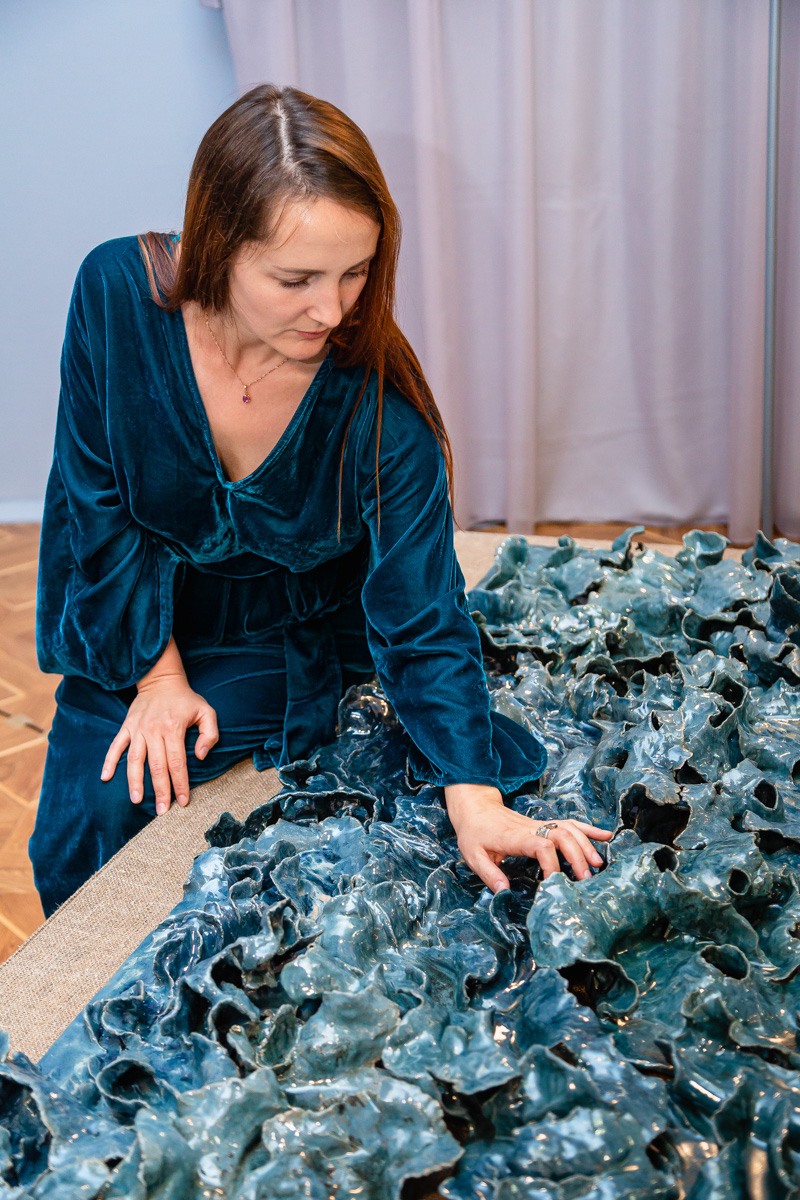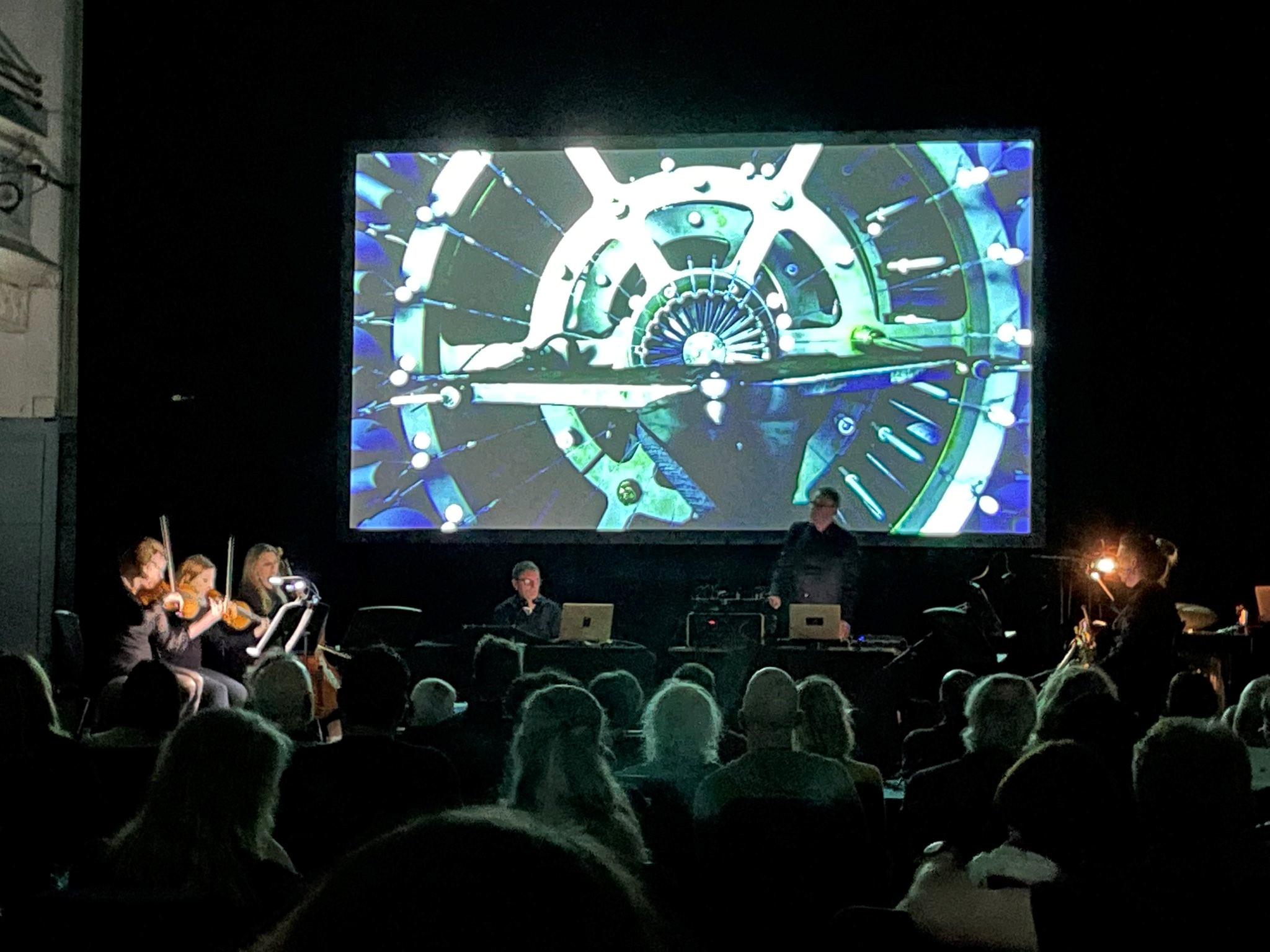
Why did you decide to choose your topic of the impact of war on marine biodiversity in the Black Sea? How did your idea for the project develop?
The Black Sea has always been a part of my life growing up. So, the motivation to focus on the effect of pollution on Black Sea biodiversity started from well before the Russo-Ukrainian war. Part of this motivation was taken into my previous project, ‘Under the Surface’, which focused on environmental issues impacting marine life in the Black Sea. The war brought forth the importance of focusing on the future of the Black Sea and its further implications on the Black Sea flora and fauna. This prompted new ideas for my EMBracing the Ocean residency and is the key focus behind the art installations created as a continuation of my ‘Under the Surface’ project.
What are the main messages that you aim to communicate with your EMBracing the Ocean project?
I wish to use my project to throw light on two main environmental issues concerning the Black Sea. The first issue is the marine litter pollution prevalent here. The Black Sea has almost twice the amount of marine litter as the Mediterranean Sea, and this was before the full-scale impact of the war (UNDP Press Release, July 2019). The second issue I want to focus on is the additional consequences of the war to the already polluted Black Sea. Due to the military actions in Ukraine, access to the Black Sea is forbidden and this has led to a drastic loss in baseline data and scientific information from it. And hence, we will have to wait until the end of the war to evaluate its consequences on the Black Sea flora and fauna and this could take a long while. I wish to use my art to bring awareness to these two topics and to also highlight the importance of sustainable development. As important as it is to talk about these environmental issues, it is equally important to encourage people to modify their daily habits and attitudes to prevent a reoccurrence of these issues in the future.
 Can you tell us a little bit about your artwork that you created for the EMBracing the Ocean residency?
Can you tell us a little bit about your artwork that you created for the EMBracing the Ocean residency?
My art installation consists of several pieces. It is a combination of two main ceramic panels - one depicting the current Black Sea situation and the other depicting the future of the Black Sea. In between these panels are ceramic sea flowers, which I used to abstractly depict the diverse inhabitants in the sea. The sea flowers are filled with water from the Black Sea, and I wanted to use this to show how the marine life and the Black Sea are interdependent, neither can survive without the other.
Having spoken to the many people who have visited your exhibitions, what kind of dialogues did your work initiate?
As expected, the war and its consequent actions were the main topics of conversation initiated by my artwork, but a close second was the discussion regarding the future of the Black Sea. People were eager to discuss what they could do as individuals to prevent such politically and ecologically disastrous issues in the future. I was especially happy that the people who attended my exhibition were equally interested in speaking with the scientists and learning more about the Black Sea from those who are working in it, and I truly hope such chats between the public and scientists happen more often in the future.
 You co-designed your work with several scientists from projects like DOORS, BRIDGE and EMBLAS. Can you tell us about your experience with the two-way co-design process of developing your project with ocean scientists? What is the value of these types of collaborations?
You co-designed your work with several scientists from projects like DOORS, BRIDGE and EMBLAS. Can you tell us about your experience with the two-way co-design process of developing your project with ocean scientists? What is the value of these types of collaborations?
My initial plan was to use current scientific information from Black Sea scientists as a basis for my artwork. Unfortunately, due to the lack of access to the Black Sea to obtain any sort of scientific information presently, I decided to work with the scientists and use their Black Sea data from previous years to create my art. It was fascinating for me to learn from the scientists about all the undiscovered potential of the Black Sea. It is also difficult for artists to link all the different kinds of scientific data from several years to create a complete picture for us to base our art on, and it was extremely useful to understand it from the scientists’ perspective - this is where the two-way collaboration was the most helpful.
What do you have planned for 2023? Will the new exhibitions be a follow-up of your Renaissance exhibition?
One of the panels from my artwork was recently selected to be shown at a new exhibition focusing on the future of Ukraine, at the Image Point Gallery in Kyiv. I am hoping to reach wider audiences through this exhibition. As part of the EMBracing the Ocean residency programme, I will be creating some new artwork with additional scientific information, that will be shown at a new exhibition in 2023, similar to the “Renaissance” exhibition. I also plan to use this exhibition as a platform where scientists can emotionally connect to the public, a space where they can explain science using anecdotes to better connect with the public.
What has been your experience in participating in the EMBracing the Ocean programme? What have you learnt during the process and how has your artistic practice evolved?
It was a multi-faceted experience for me, personally. I valued the new experiences involving the consultation and collaboration with the scientists and I appreciated all the help that EMB provided in finding the right scientists to collaborate with. It was also a learning experience artistically because this residency project helped me experiment with ceramics. EMB also provided me with the opportunity to display my work to audiences, both nationally and internationally. I want to point out how refreshing and supportive it felt to be able to chat and share my work with people from different nationalities and stages of life, especially given the current situation in Ukraine.
.jpg) In general, people in war torn countries cannot care about the environment or about living sustainably, because they have bigger things to worry about. But that is not something that most people understand. How can art help with changing people’s perspectives on the importance of sustainability?
In general, people in war torn countries cannot care about the environment or about living sustainably, because they have bigger things to worry about. But that is not something that most people understand. How can art help with changing people’s perspectives on the importance of sustainability?
You are right when you say that most people in Ukraine cannot think about much else but the war, the military actions, and their future implications. But many people that I have spoken to are of the opinion that at the very least, art is most helpful in allowing people to take a well-earned break from the war situation. Many in Ukraine have family who are volunteering in the war, and it is difficult for them to not worry every day. In a way, art is healing. Art gives people hope for a peaceful future, it will help them look forward to a future where there is no worry of the war.
Why did you decide to choose your topic of exploring the complexity and beauty of the Southern Ocean? How did your idea for the project develop?
I guess it was through the mystery of it. In an earlier project, I had been working with the Arctic, and that is a relatively well-known area with known issues. Most of the Arctic scientists I was collaborating with were also working in the Antarctic, and every time one of them tried to explain the latter to me, I found myself getting quite lost in the complexity of it. So, I decided that I would work on it next, because aside from wanting to learn more about the Antarctic myself, I believed that it would be valuable to bring awareness to the issues surrounding this region to those outside the scientific community who were probably as unaware about them as I had been.
Could you give us a quick overview on how you worked with the scientific data and how you incorporated those into your musical compositions?
I work together with scientists on both observational data and models. This data arrived to me as long streams of numbers. I adapted and scaled this information into a format that could be more easily understood by music software. Each data element, for instance, salinity, surface temperature, depth of the thermocline, ice coverage, wind speed, etc. plays its own part in an ensemble piece of music.
(At the following links you can find soundclips of Michael's thermocline, polynya and salt flux work)
 What are the main messages that you aim to communicate with your EMBracing the Ocean project?
What are the main messages that you aim to communicate with your EMBracing the Ocean project?
Unlike the Arctic and other regions, there is a sense that the greatest damage has not yet occurred in the Antarctic. Nevertheless, there are signs showing us that this tipping point is growing closer. And once we reach this tipping point, the consequential damage to the planet will be swift and brutal. One of the key areas to watch out for is the undermining of the ice shelves on the western end of the Antarctic. We are getting to a point where warmer water can get under the ice shelves and undermine it from beneath. And if that happens, the Antarctic ice sheet will just pour out and the global ocean will change quickly, gaining almost a metre and a half, leading to catastrophic changes globally.
Do you think your selected mode of creative communication has connected to your target audience?
That process is still underway for my EMBracing the Ocean project. In my previous work, that has been the case. The outreach has not been as far-reaching as I would have liked since sound art is quite a peripheral cultural activity. But that also means that I can get my music to reach an audience that grasp the material. The audience that listens to experimental music and sound art tends to really like the music and want to know all about it, including its drivers and triggers. They take a deeper interest than the casual listener, so they will be more keenly aware of the issues informed in the music. When my current music will be released, it will be accompanied by a lot of written material from the scientists. So, there should be ample opportunities for people to learn more about the topic while listening to the music.
Can you tell us about your experience with the two-way co-design process of developing your project with Ocean scientists?
I am eternally grateful and humbled by the amount of attention the scientists have given to try and explain their work to me, and to provide me with the data that I need for my work. From my experiences in this project and the previous one, there is a common meeting ground in no-man’s land wherein both the scientists and artist must come out of their comfort zones and help each other out. The value of that is that it shines a light on the more creative aspects of the scientists’ endeavors. We meet in a territory where I can create sounds from the science that they have given me, and they have to reconsider that data in terms of how it sounds and what the musical narrative is saying in terms of what the work has uncovered. In brief, my role involves the creation of an aesthetic and creative response to their pure data.
Speaking of collaborations, could you tell us some more about your collaboration with EMBracing the Ocean artist Lera Litvinova?
Lera had been in touch with me to inform me how much she enjoyed the science behind my music. We got to talking and ended up developing a plan for me to turn some of my technology towards some data sources involving the Black Sea and the Sea of Azov. Through her work in the Black Sea, she realized that there is a true threat of ecocide happening because of the war in the Black Sea, which was already in an ecologically precarious state. But her main concern was regarding the fact that because of the war, it would be several years before we could evaluate the actual impact on the ecological systems in the Black Sea. Our plan was that I would make some sounds using whatever open-source data I could obtain from the Black Sea, and I would travel to Ukraine and give a performance at Lera’s exhibition, along with some of the members from UK’s Black Glass Ensemble and other Ukrainian artists. This was planned for mid-November 2022, but we had to sadly call it off due to new crises cropping up in Ukraine linked to the war. For the time being though, those recordings have been developed as a series of recordings that were broadcast in December 2022 and which you can find here.
How did you find your scientific collaborators and what advice do you have for other artists who are also interested in working with scientists?
To find scientific collaborators we must cast a very broad net. But we require a lot of help from organisations such as EMB, because you have a broader connection to the scientific community than we do. However, serendipity had a major role to play in the main contact that I got connected to initially. I was giving online tutorials on a software I use, and one of my students was interested in developing something in this area because of her cousin who was a scientist interested in doing the same. Over the course of the tutorial, we decided that it would be better if I were to work with her cousin rather than expect her to learn everything about the software from scratch. So, she introduced me to her cousin who is Lukrecia Stulic, who has now been my core collaborator for these past two projects now. In my case, since Lukrecia was so enthused with our work, she managed to get more of her coworkers on board. My main advice would be to cast a wide net, and to just wait and see what nibbles. And do not be discouraged if you do not find scientists who are interested in what you want to do, that takes time.
From your experience, do the scientists get new insights into their research by listening to the music derived from your data?
In a sense, yes. The insights do not come directly - they do not listen to the musical data and look for changes and patterns in there. It is what arises through the process where these changes happen. During my process of creating voices for each element, the scientists have gone back on occasion and wondered if there can be a potential refinement in their work to get to the narrative explanation that I am arriving at. Listening to my data shows them a slightly different perspective that could be taken on the data, to report it in a more effective way. This process of engaging with the creative side of their work and reflecting on their own work is of value. Scientists also want their work to be known and working in such cross-disciplinary collaborations with artists provides opportunities for them to connect with audiences far beyond academia.
-------------
Throughout the interviews, I noticed that something both Lera and Michael were passionate about and had in common with their work was the emotional connection they wanted their art to have with the audience. As artists, evoking an emotional feeling with their art is key, and both Lera and Michael have been successful in that stance. More often than not, people need to have that emotional connection with the environment to be invested in taking care of it, and this emotional investment is something both hope to bring about with their art. Lera and Michael have huge plans and hopes for the future in terms of their evolving arts. Continuing to carry their works and merged collaborations forward is just one step in their growing wave, and it is something they both look forward to. We are excited for everything they have planned for their future and cannot wait to see what they have coming up next!
Find out more about the EMBracing the Ocean programme here. The call for artists for the 2023 - 2024 programme is open for applications until 20 February 2023.